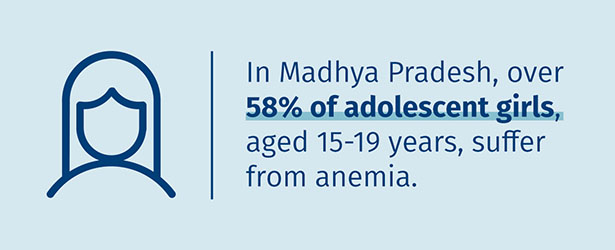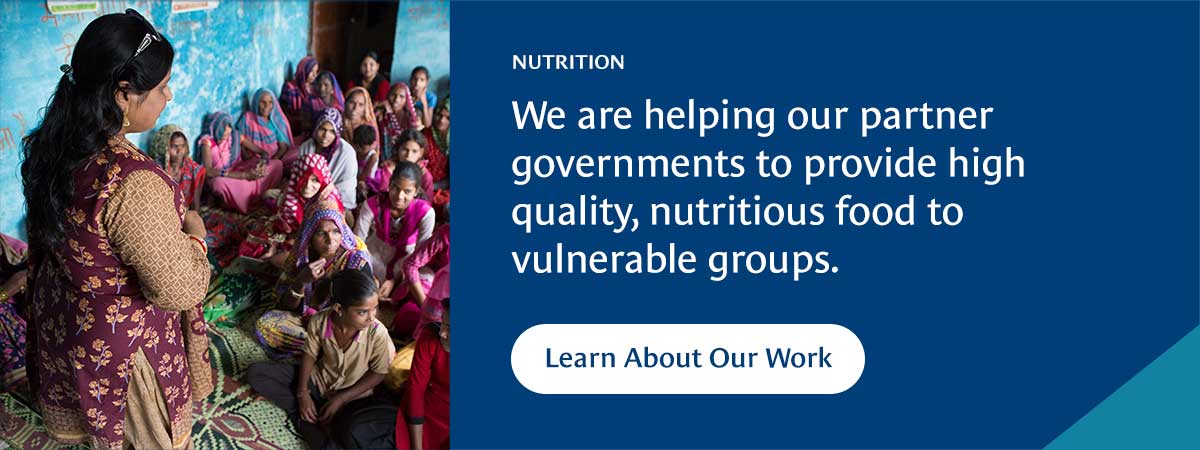Vidisha is a high-priority district in Madhya Pradesh with a high burden of anemia. A local youth leader shares her experience and learning about the importance of good nutrition and iron and folic acid supplements in the prevention of anemia.
Geeta* was 13 years old when she started taking iron and folic acid (IFA) supplements at school.
Every Tuesday, supplements are distributed at the public school in her village, as part of the government of India’s Anemia Mukt Bharat (or Anemia-Free India) program, implemented with technical and programmatic support from development partners like CHAI.
After lunch, Geeta and her peers queue up to receive the supplements from their teacher, but there are many who miss the dosage for reasons such as fear of side effects.
As the head girl, Geeta assumes an important role in ensuring adherence to IFA supplementation at her school, checking on her peers, and reminding them of the health benefits of IFA. Geeta knows that fatigue, dizziness, skin pallor, and shortness of breath are some of the common symptoms of anemia and if any of her peers show such symptoms, she informs the teacher without delay. Occasionally, on her way back home from school, Geeta collects the IFA tablets for her mother, which are available free of cost at the nearby Anganwadi Center, as her mother is often busy taking care of her three months old sister.
Enabling this kind of community engagement and action is the backbone of People-Powered Newtrition, CHAI’s flagship approach to redefining nutrition in Madhya Pradesh (MP), one of the Indian states with a high prevalence of anemia.
Delivering for girls in Madhya Pradesh

In rural Madhya Pradesh, over 58 percent of adolescent girls (aged 15-19 years) suffer from anemia.[1] Further, factors such as limited access to iron and folic acid (IFA), low awareness of its benefits, and fear of side effects from consuming it, lead to low uptake of IFA among this high-risk group.
The challenge that anemia vulnerability poses to adolescent girls is of special interest to health experts because a shift towards positive nutrition behavior at this critical age can help break the intergenerational cycle of anemia, in which these anemic adolescent girls, after getting married in a few years, pass on anemia to their offspring.
Over the past five years, CHAI’s People-Powered Newtrition Program has made several important strides towards reducing MP’s anemia burden by leveraging community resources, local knowledge, and existing nutrition systems to harmonize policy commitments and scale-up initiatives across the areas of nutrition, food systems, women, and children’s health in the state.
Perhaps, CHAI’s most transformative contribution to strengthening the government’s anemia control efforts in MP has been to support the design and implementation of a new IFA distribution mechanism. The approach harnesses the surplus capacity of the state’s robust vaccines’ supply chain to ensure timely delivery of IFA from district warehouses to health facilities while mimicking the Alternate Vaccine Delivery (AVD) model (where local persons are engaged and compensated for delivering the vaccine from health facility to last-mile service delivery node or immunization sessions) for delivery of IFA from health facilities to the schools and Anganwadi Centers (AWCs) through Drug Delivery Personnel (DDPs). This mechanism, augmented by CHAI’s data-enabled platform for tracking the delivery and availability of IFA at the service delivery points, is believed to have considerably reduced stock-outs at schools and community health platforms (including AWCs) across the state.
Furthermore, to address the community-related barriers to IFA uptake, CHAI mobilized a field force of 130+ members to build the capacity of 150,000 frontline health workers to improve their knowledge and better equip them to counsel women and girls in the community about anemia.
Agents of transformational change
Geeta began to encourage her peers to attend the bal sabhas, group meetings for sixth – eighth standard students, and urged any women in a family who are pregnant or lactating, to participate in the matru sabhas, a community-based platform for mothers. These events are a part of a mammoth effort to engage children, adolescents, mothers, including pregnant and lactating women, in the conversation on nutrition, and counsel them on good dietary practices, matters like breastfeeding and complementary feeding, as well as anemia identification and control methods, including dosage and benefits of IFA tablets.
It was at one such session that girls previously reluctant to consume IFA, learned of its role in overcoming anemia, especially for menstruating women and girls, for whom sources of iron are often missing from daily diets. Gradually, they opened up in these safe spaces, sharing accounts of dizzy spells and lethargy stemming from iron deficiencies, and how this impeded their learning activities. The facilitators patiently explained how to identify anemia symptoms and follow good nutrition practices.
After five years of close engagements with the community, these girls now actively support all local nutrition-focused interventions, going door-to-door to guide peers to the schoolyard or Anganwadi Center for bal sabhas and matru sabhas, as well as to spread the message of Boli – Iron ki Goli, an IFA consumption awareness campaign devised by CHAI.
As future drivers of improved nutrition engaged communities of youth leaders are more than just beneficiaries of people-powered programs—they are the central actors who will create a sustainable ecosystem for Newtrition long after the program has concluded, and help scale it up in the future.
*Geeta’s name has been changed to maintain anonymity.
[1] National Family Health Survey (2019-2021)






